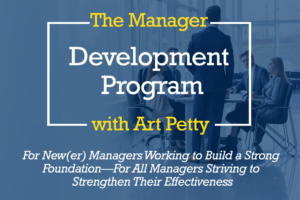Sorry, S.M.A.R.T. Goals, But Your Day is Over
OK, a confession: I wanted to title this article something like “Why Your S.M.A.R.T. Goals are Dumb, but my topic is a bit more expansive than just my disdain for that all-too-present and limiting corporate approach to goal-setting. I will get my shots in, though.
Good Goals Drive Personal Growth and Organizational Impact
Goals are critically important in our personal and professional growth. They push us to learn, grow, and strive. We change our lives by aspiring for big goals. We motivate ourselves and our team members with properly developed, challenging goals. And we change the vector and fate of organizations through the proper use of goals. The operative phrase is “the proper use of goals.”
In my work with hundreds of managers each year, I mostly see poorly designed goals–typically leveraging S.M.A.R.T) and a wholesale lack of managerial coaching for goal achievement.
Too many managers and contributors are in compliance mode, working on completing H.R.-driven goals forms as part of annual or semi-annual evaluations. The forms, processes, and ultimately the words passing for goals fail to leverage the ample research on goals and goal development. Too many end up as tactical efforts, such as: attending a training course on X or strengthening my communication skills.
While in reality, S.M.A.R.T. might not be the total culprit, individuals using this framework tend to focus on the “A” as achievable or attainable. In the research, fewer, larger goals are tied to higher performance.
Set Bigger Goals, According to Marc Effron
In Marc Effron’s excellent, research-based 8 Steps to High Performance, his first step offers “Set Big Goals.” (I recommend this book to every client as a must-read and permanent addition to their professional library.)
A few of Effron’s highlights (excerpted and paraphrased) drawn from Locke and Latham and others include:
It’s a fundamental scientific fact–goals improve performance.
Bigger goals increase what you deliver.
Science has found that bigger goals deliver bigger results.
Fewer goals mean higher achievement
Most leaders underperform at goal setting because they have too many, too small goals that are not prioritized.
If Goals Are Potentially Transformational, What Can We Do to Harness Them?
Years ago, my co-author for Practical Lessons in Leadership, Rich Petro, suggested that teaching individuals and managers how to develop and pursue goals correctly was much more complicated than most people thought. I chewed on that for a while and jumped into the research. Rich was and is correct. It takes time and focus on getting good at setting, executing, and ultimately coaching or gaining coaching on goals. However, now is an excellent time to start. Here’s my guidance:
8 BIG Things You Can Do to Harness the Power from Great Goal Setting
1. Use a S.L.I.M. format for Specific, Learning-Oriented, Impactful, and Measurable.
This framework solves my dilemma with S.M.A.R.T. It leverages the research that suggests goal achievement demands learning and that proper goals are impactful to our organization or environment.
2. Focus On Purpose and Impact
Purpose is rocket fuel for big goals. Start here. If you don’t feel the personal driver behind the goal, it’s just corporate compliance. And if the goal isn’t going to have a significant positive impact on your organization, don’t bother.
3. Turbocharge Learning and Innovation
The potential for impact will challenge you to learn, innovate, experiment, and iterate along the way. A good goal demands massive learning and process creation. While purpose launches the goal, learning fuels progress, and the potential for impact helps you focus.
4. Develop Fewer, Larger Goals
If you have more than three goals at any point, drop at least one. Work with your boss to identify the one or two that fit the S.L.I.M. format. If your corporate goals form demands five, send a link to this article and Effron’s book to the right people.
5. Be a Rebel and Convert S.M.A.R.T. to S.L.I.M.
OK, we’re operating on the side of goodness here despite the provocative title. Comply with your process if you cannot change it. Just prioritize the top one or two goals with your boss and rethink them in the S.L.I.M. format.
6. Seek Coaching for Your S.L.I.M. Goal(s).
Make your S.L.I.M. goals progress, insights, and needs a part of your 1×1 with your manager. Cultivate outside resources who can support you on your journey.
7. If You are the Manager, Give Coaching
If you are the manager, first, stop giving goals to your people. Work with them collaboratively to develop S.L.I.M. goals and then make the progress part of your regular 1×1 discussions. Provide learning support, offer access to resources, and provide positive encouragement along the way.
8. Make Your Goal(s) Public and Don’t Constraint Them to an Evaluation Cycle.
Years ago, I committed to 250 coworkers at a company town hall meeting that our software firm would lead the Gartner Magic Quadrant for our category. There were two problems here with my commitment. First, Gartner didn’t have a Magic Quadrant for the category. And second, not a single person on my team had experience working with analysts, myself included. The impact when we were successful would be profound, and this purpose drove us to success.
It took several years and absolutely didn’t fit into a performance evaluation cycle. We sought training, developed briefing tools and processes, and worked at this relentlessly until we were successful. And yes, the Impact was profoundly powerful for the business and, ultimately, the stakeholders.
A Word of Caution
Goals can promote aberrant behaviors and send individuals and organizations down dark holes filled with ethical quandaries. (Can you say Wells Fargo?) Goals should constantly be scrutinized for the behaviors they incentivize and those they discourage. (For a resource reference, check out Goals Gone Wild: The Systematic Side-Effects of Over-Prescribing Goal Setting via HBR.)
The Bottom Line for Now:
Run an experiment on yourself, develop just one Specific, Learning-Focused, High Impact, Measurable goal, and commit to it. Do the work. Refrain from constraining yourself to a performance evaluation period. Make sure the goal is important to you and impactful to your organization. And bring it to life. Help your team members do the same.
![]()
If you are ready to transform the manager role in your organization, consider signing up your team for an upcoming session of the Manager Development Program.


